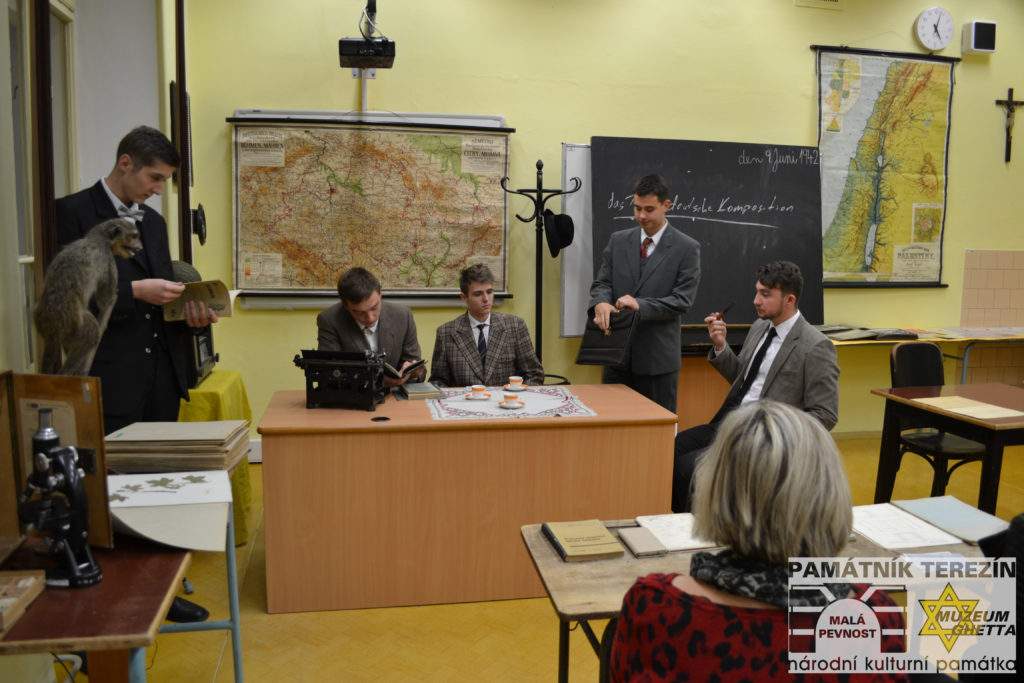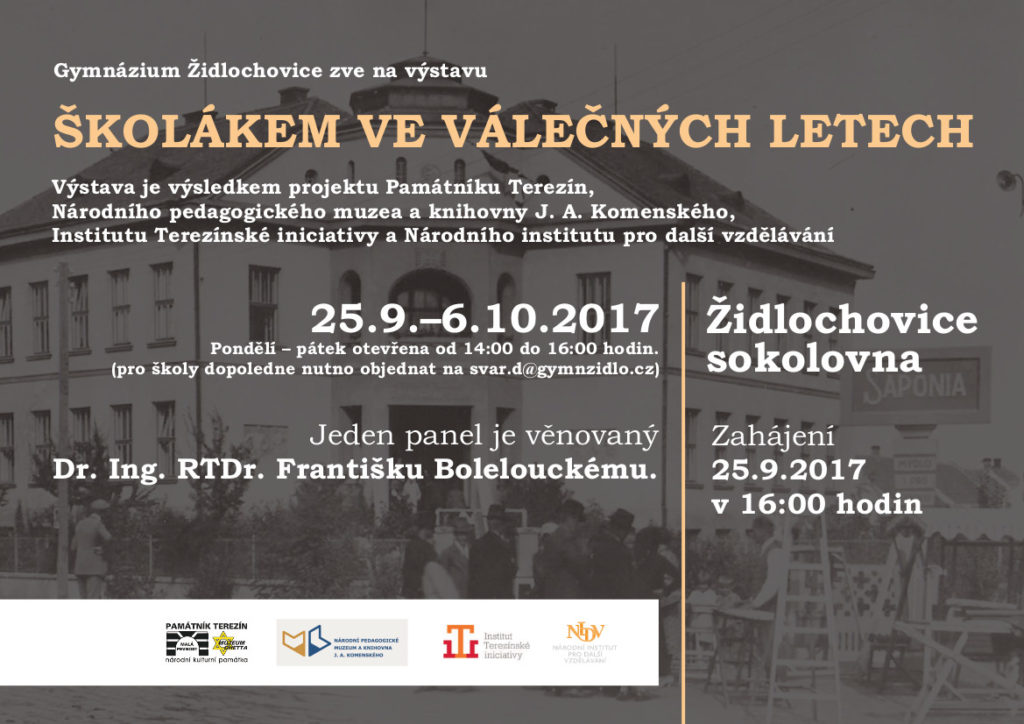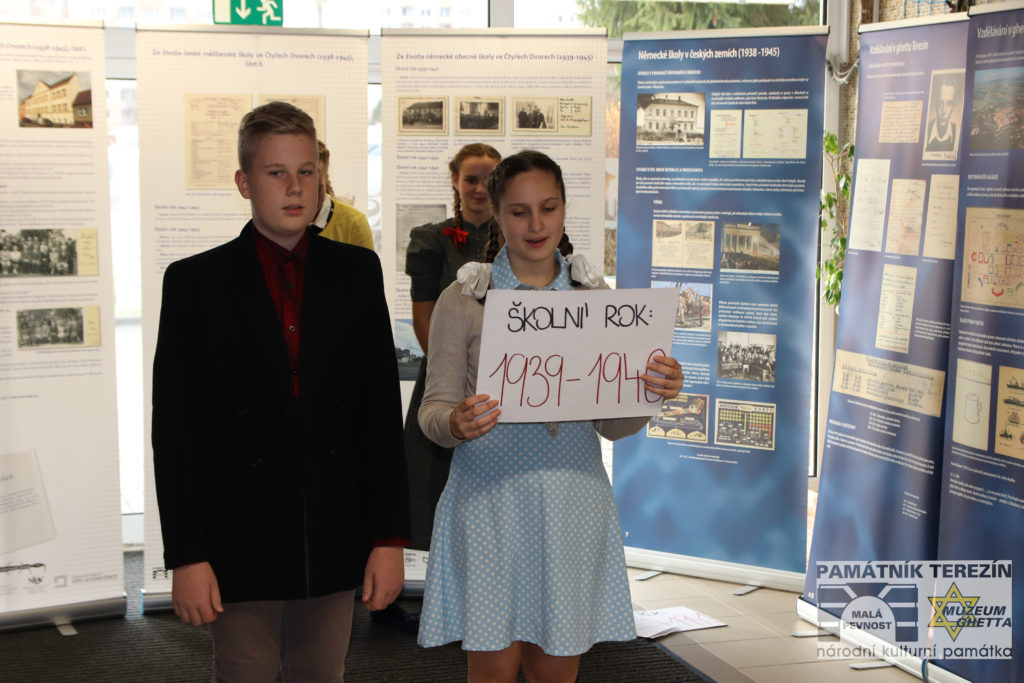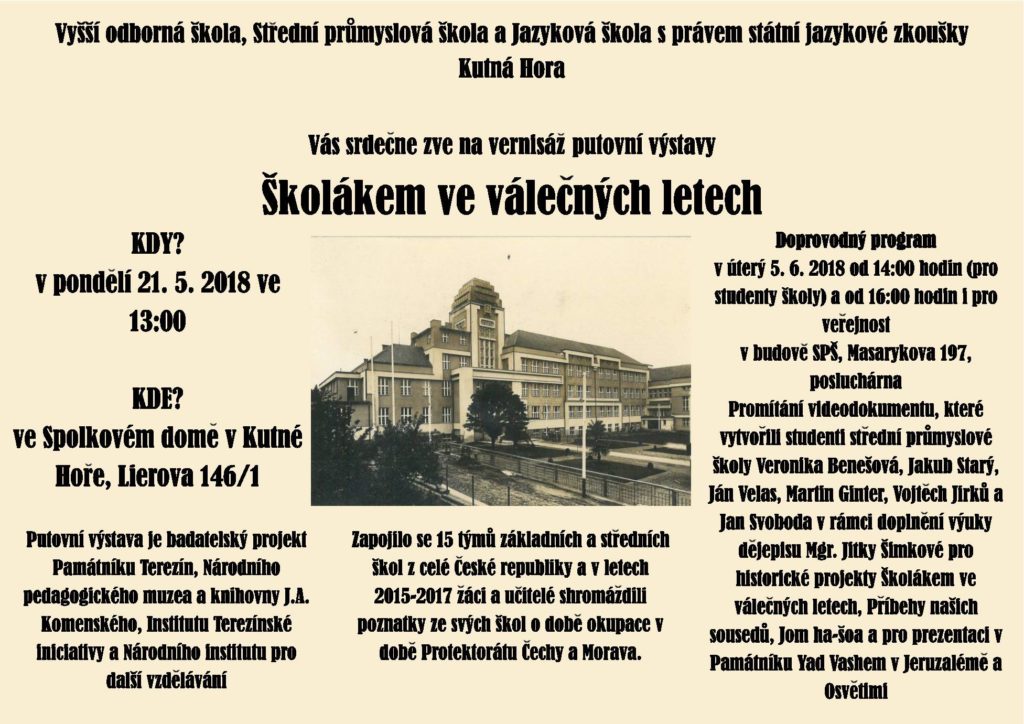Two years elapsed in March this year since the opening of a touring exhibition entitled Being at School in the War Years (1938 – 1945) in the Faculty of Education of the Charles University in Prague. The display summed up the work carried out by the teams taking part in the project of the same name during the school year 2015-2016. Then, in May 2017, the travelling exhibition set out on its journey through many regions in the Czech Republic. By the end of March 2019, the exhibition had already been staged in 17 Czech towns and villages, being installed in some of them even twice on two different sites. Since we have reported on the project Being at School in the War Years on the pages of the Terezín Memorial´s Newsletter on several previous occasions, this article will be devoted solely to the circumstances relating to the individual stopovers of the current touring exhibition.

During the first leg of its tour the exhibition was staged in the towns where most of the participating schools (with a single exception) are located. This stage lasted for approximately one year. The display was installed at the elementary school at Morkovice near Kroměříž, at the Uherské Hradiště high school, at the Svatobořice – Mistřín elementary school, at the elementary school at Modřice near Brno, at the Židlochovice high school, at the high school and secondary vocational school in Moravské Budějovice, at the elementary school in Oskar Nedbal Street in České Budějovice, at the elementary school in Jirásek Park in Příbram, and at the Luděk Pik high school in Pilsen. In addition to these schools, the exhibition was installed during the first year of its tour in the hall of the Community Care Service at Radnice (pupils from the local elementary school also participated in the project), in the State District Archive in Příbram (following its installation at the Jirásek Park elementary school), in the Rectorate of the University of South Bohemia in České Budějovice (after being held in the elementary school in Oskar Nedbal Street). During a preview of the exhibition in the Rector´s Office historian Prof. PhDr. Václav Bůžek, CSc. had only words of praise for the display. It was also staged in the atrium of the Milovice Municipality building (the local elementary school was also involved in the project), in the Community Center in Kutná Hora (students from the local higher vocational school, secondary technical college and language school also took part in the project), in the Hlízov Community Center (two members of a local public enlightenment society were part of the project), or at Zámeček in Pardubice (most of the credit for this installation goes to Mgr. Marie Hřebíková, who was engaged in the project together with the pupils of the local elementary school and the school for mentally handicapped children Svítání, o. p. s. Mrs. Hřebíková then addressed the Association of Czechoslovak Legionaires, the institution administering Zámeček, and asked for permission to stage the display in the object).

While installing the exhibition, some of the above-mentioned schools combined it with diverse accompanying programs. For instance, Mgr. Eva Pátíková (née Bánská) teaching at the elementary school at Morkovice near Kroměříž (the exhibition panels went on display there for the first time outside Prague) prepared for her schoolchildren special worksheets to be used in teaching about the topics covered by the exhibition. In a similar vein, Mgr. Danuše Švarzbergerová, together with her colleague Mgr. Tomáš Dratva at the Židlochovice high school, organized visits to the exhibition not only for the local high-school students but also for pupils of a local elementary school. Thanks to that, as many as 800 visitors could view the display, among them nephew of director František Boleloucký (executed during the Nazi occupation for his resistance activities). The story of his anti-Nazi resistance was the subject of the research, carried out by Jan Hroudný, a student of the Židlochovice high school, within the project itself and also in his other studies. For their part, high-school students in Moravské Budějovice furnished for the preview of the exhibition their classroom with period school benches and other furniture, and rehearsed, under the guidance of their teacher Mgr. Květa Bretšnajdrová, a short performance inspired by the Czech feature film Vyšší princip (Higher Principle) that described Nazi reprisals against Czech students following the military operation against Reinhard Heydrich in WWII. A scene portraying school life at Nové Dvory near České Budějovice was also rehearsed and performed by pupils from České Budějovice´s elementary school in Oskar Nedbal Street with the help of their teacher Mgr. Dagmar Boudová. Thanks to teachers Mgr. Jana Třetinová and Bc. Leona Mikušová, heads of the project at the T. G. Masaryk elementary school in Milovice, the atrium of the local town hall was partly turned, during an exhibition preview, into a Protectorate classroom lined by showcases containing historical documents, textbooks and other exhibits, on loan from the Elbe Region Ethnographic Museum in Přerov nad Labem. In addition to that, visitors could watch a cultural program featuring performances by local schoolchildren. And last but not least, mention should be made of the students of the higher vocational school in Kutná Hora, who – under the guidance of Mgr. Jitka Šimková – staged, as part of the display, an accompanying program in their town, complete with the screening of a video document produced by a student.

As for the actual course of the tour, described above, the exhibition was generally handed over, with minor exceptions, by one individual school participating in the project to another. As a result, the

Invitation to a preview of the exhibition staged by a team from the higher vocational school and the secondary technical college in Kutná Hora, May 2018. School archives. 
Preview of the exhibition, held by the T. G. Masaryk elementary school in Milovice, was also attended by Mrs. Libuše Hlavsová, née Matoušová, one of the survivors, found by the pupils during their project, April 2017. Photo: Jan Špringl.
The 2-year track record of the touring exhibition Being at School in the War Years (1938 – 1945) so far has been highly encouraging for us; it is particularly important that in this way the results of the project have been presented to the general public on a long-term basis. The useful work done by the Czech pupils and students will be further promoted by means of a new web of the project also capturing research outputs produced (not only) by the above-mentioned schools.
Šp


